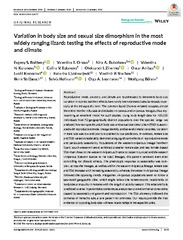Приказ основних података о документу
Variation in body size and sexual size dimorphism in the most widely ranging lizard: testing the effects of reproductive mode and climate.
| dc.creator | Roitberg, Evgeny S. | |
| dc.creator | Orlova, Valentina F. | |
| dc.creator | Bulakhova, Nina A. | |
| dc.creator | Kuranova, Valentina N. | |
| dc.creator | Eplanova, Galina V. | |
| dc.creator | Zinenko, Oleksandr I. | |
| dc.creator | Arribas, Oscar | |
| dc.creator | Kratochvíl, Lukáš | |
| dc.creator | Ljubisavljević, Katarina | |
| dc.creator | Starikov, Vladimir P. | |
| dc.creator | Strijbosch, Henk | |
| dc.creator | Hofmann, Sylvia | |
| dc.creator | Leontyeva, Olga A. | |
| dc.creator | Böhme, Wolfgang | |
| dc.date.accessioned | 2020-09-09T10:37:56Z | |
| dc.date.available | 2020-09-09T10:37:56Z | |
| dc.date.issued | 2020 | |
| dc.identifier.issn | 2045-7758 | |
| dc.identifier.uri | https://onlinelibrary.wiley.com/doi/10.1002/ece3.6077 | |
| dc.identifier.uri | http://www.pubmedcentral.nih.gov/articlerender.fcgi?artid=PMC7297768 | |
| dc.identifier.uri | https://radar.ibiss.bg.ac.rs/123456789/3862 | |
| dc.description.abstract | Reproductive mode, ancestry, and climate are hypothesized to determine body size variation in reptiles but their effects have rarely been estimated simultaneously, especially at the intraspecific level. The common lizard (Zootoca vivipara) occupies almost the entire Northern Eurasia and includes viviparous and oviparous lineages, thus representing an excellent model for such studies. Using body length data for >10,000 individuals from 72 geographically distinct populations over the species' range, we analyzed how sex-specific adult body size and sexual size dimorphism (SSD) is associated with reproductive mode, lineage identity, and several climatic variables. Variation in male size was low and poorly explained by our predictors. In contrast, female size and SSD varied considerably, demonstrating significant effects of reproductive mode and particularly seasonality. Populations of the western oviparous lineage (northern Spain, south-western France) exhibited a smaller female size and less female-biased SSD than those of the western viviparous (France to Eastern Europe) and the eastern viviparous (Eastern Europe to Far East) lineages; this pattern persisted even after controlling for climatic effects. The phenotypic response to seasonality was complex: across the lineages, as well as within the eastern viviparous lineage, female size and SSD increase with increasing seasonality, whereas the western viviparous lineage followed the opposing trends. Altogether, viviparous populations seem to follow a saw-tooth geographic cline, which might reflect the nonmonotonic relationship of body size at maturity in females with the length of activity season. This relationship is predicted to arise in perennial ectotherms as a response to environmental constraints caused by seasonality of growth and reproduction. The SSD allometry followed the converse of Rensch's rule, a rare pattern for amniotes. Our results provide the first evidence of opposing body size-climate relationships in intraspecific units. | en |
| dc.publisher | John Wiley and Sons Ltd | |
| dc.relation | Deutsche Forschungsgemeinschaft (grant RO 4168/1-3) | |
| dc.rights | openAccess | |
| dc.rights.uri | https://creativecommons.org/licenses/by/4.0/ | |
| dc.source | Ecology and Evolution | |
| dc.subject | Bergmann's rule | |
| dc.subject | Rensch's rule | |
| dc.subject | Zootoca vivipara | |
| dc.subject | Ecogeographic body size clines | |
| dc.subject | Life‐history | |
| dc.subject | Lizards | |
| dc.title | Variation in body size and sexual size dimorphism in the most widely ranging lizard: testing the effects of reproductive mode and climate. | en |
| dc.type | article | en |
| dc.rights.license | BY | |
| dcterms.abstract | Роитберг, Евгенy С.; Орлова, Валентина Ф.; Булакхова, Нина A.; Куранова, Валентина Н.; Епланова, Галина В.; Зиненко, Олександр И.; Кратоцхвíл, Лукáш; Стариков, Владимир П.; Стријбосцх, Хенк; Хофманн, Сyлвиа; Леонтyева, Олга A.; Бöхме, Wолфганг; Aррибас, Осцар; Љубисављевић, Катарина; | |
| dc.rights.holder | © 2020 The Authors. Ecology and Evolution published by John Wiley & Sons Ltd. | |
| dc.citation.issue | 11 | |
| dc.citation.volume | 10 | |
| dc.identifier.doi | 10.1002/ece3.6077 | |
| dc.identifier.pmid | 32551042 | |
| dc.identifier.scopus | 2-s2.0-85089523021 | |
| dc.identifier.wos | 000530559100001 | |
| dc.citation.apa | Roitberg, E. S., Orlova, V. F., Bulakhova, N. A., Kuranova, V. N., Eplanova, G. V., Zinenko, O. I., et al. (2020). Variation in body size and sexual size dimorphism in the most widely ranging lizard: testing the effects of reproductive mode and climate. Ecology and Evolution, 10(11), 4531–4561. | |
| dc.citation.vancouver | Roitberg ES, Orlova VF, Bulakhova NA, Kuranova VN, Eplanova G V., Zinenko OI, Arribas O, Kratochvíl L, Ljubisavljević K, Starikov VP, Strijbosch H, Hofmann S, Leontyeva OA, Böhme W. Variation in body size and sexual size dimorphism in the most widely ranging lizard: testing the effects of reproductive mode and climate. Ecol Evol. 2020;10(11):4531–61. | |
| dc.citation.spage | 4531 | |
| dc.citation.epage | 4561 | |
| dc.type.version | publishedVersion | |
| dc.identifier.fulltext | https://radar.ibiss.bg.ac.rs/bitstream/id/7245/bitstream_7245.pdf | |
| dc.citation.rank | M22 |

